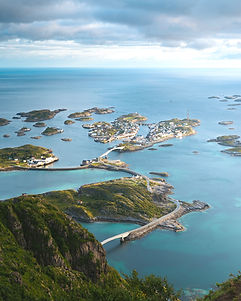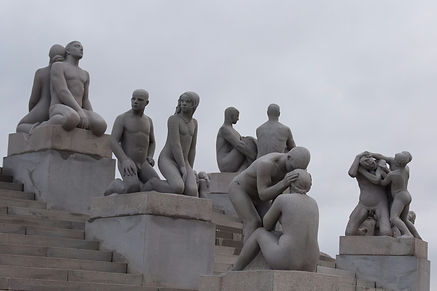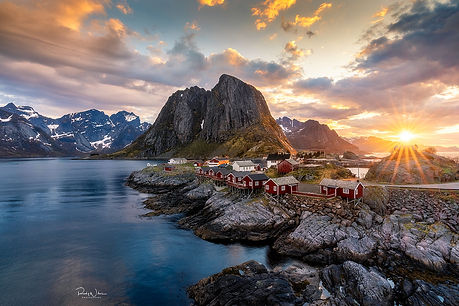Country Info | Read more
Flags are sourced from free platforms like flagpedia.net
Norway
Norway is a land of majestic fjords, vibrant cities, and stunning Arctic landscapes. Visit Oslo, the Lofoten Islands, and witness the northern lights for an unforgettable Scandinavian experience.
* Affiliate links are marked with an asterisk (*). We may earn a commission at no extra cost to you.
Photos without credits are sourced from free platforms like Unsplash and Pexels





Summary
Did you know?
A Town with No Sun for Months – In Svalbard, the sun never rises for over two months in winter, but in summer, it never sets!
Overview
Months
10. October, 05. May, 03. March, 11. November, 06. June, 09. September, 07. July, 01. January, 12. December, 02. February, 08. August, 04. April
Vacation type
Couple, Family, Nature, Sightseeing, Hiking, Skiing, Mountains
Expenses
<100€, <150€, <200€, Over 200€
Temperature
Under 0°C, 0-10°C, 10-20°C
Rainfall
0-50mm, 50-100mm
Safety
Safe
Continent
Europe
Currency
Norwegian krone
Languages
Norwegian, Sami
Currency Converter
When to visit
The best time to visit Norway is during the summer months from June to August. During this period, you can experience the country’s stunning landscapes with mild temperatures, long daylight hours, and minimal rain, which is ideal for exploring fjords, hiking, and enjoying outdoor activities.
- June to August: Features pleasant weather with temperatures ranging from 10°C to 21°C (50°F to 70°F) and the famous midnight sun in the northern regions, making it a great time to explore both urban areas like Oslo and natural wonders such as the Geirangerfjord and the Lofoten Islands.
- May and September can also be good times to visit, with fewer tourists and still relatively mild weather, though temperatures can vary and there may be more rain.
- Winter (December to February) is best for experiencing Norway’s winter sports and the Northern Lights, especially in the northern regions. However, expect cold temperatures, shorter daylight hours, and potentially challenging travel conditions in snow-covered areas.
-
Plan the whole vacation, including flights, transportation, hotels and tours with Expedia *
Climate Data
Peak Season (June to August)
Average Sunny Hours per Day: 8 to 10 hours.
Rain Frequency: Occasional, mostly dry during summer.
Rainy Hours per Day: 1 to 2 hours.
Intensity: Light rain or brief showers.
Duration: Short-lived, usually less than an hour.
Off-Peak Season (September to May)
Average Sunny Hours per Day: 3 to 5 hours.
Rain Frequency: Frequent, particularly on the west coast.
Rainy Hours per Day: 2 to 3 hours.
Intensity: Light to moderate rain or snow.
Duration: Rain can last for several hours, especially in the winter.
Climate Chart
_edited_edited_edited_e.jpg)
Data Source: Global Historical Climatology Network
ClimateCharts.net
Weather, Crowds and Costs
Per one person
Tourist Season: June-August (Summer)
Budget Vacation ($60-150/day)
Accommodation: $30-80/night (budget hostels, guesthouses).
Food: $20-50/day (local meals, street food).
Activities: $10-30/day (nature walks, sightseeing).
Transportation: $10-20/day (local transport, buses).
Other Costs: $5-10/day (souvenirs).
Mid-Range Vacation ($150-300/day)
Accommodation: $80-180/night (mid-range hotels, boutique lodges).
Food: $30-70/day (restaurants, cafes).
Activities: $20-50/day (guided tours, fjord tours).
Transportation: $20-50/day (car rentals, taxis).
Other Costs: $10-20/day (shopping, souvenirs).
Luxury Vacation ($300+/day)
Accommodation: $180+/night (luxury resorts, boutique hotels).
Food: $50+/day (fine dining).
Activities: $50+/day (private tours, luxury experiences).
Transportation: $30+/day (private transport, chauffeur services).
Other Costs: $20+/day (luxury shopping).
Off-Peak Season: October-May (Fall-Winter)
Budget Vacation ($50-100/day)
Accommodation: $25-50/night (budget hostels, guesthouses).
Food: $15-40/day (local food, restaurants).
Activities: $10-20/day (museums, hiking).
Transportation: $10-20/day (local transport).
Other Costs: $5-10/day (souvenirs).
Mid-Range Vacation ($100-250/day)
Accommodation: $50-120/night (mid-range hotels, boutique stays).
Food: $20-50/day (restaurants, cafes).
Activities: $20-50/day (private tours, activities).
Transportation: $15-30/day (local transport, taxis).
Other Costs: $10-20/day (shopping).
Luxury Vacation ($250+/day)
Accommodation: $120+/night (luxury resorts, private cabins).
Food: $40+/day (fine dining).
Activities: $40+/day (private tours, luxury activities).
Transportation: $20+/day (private cars, taxis).
Other Costs: $15+/day (luxury shopping).
-
You can find accomendations that fit your trip and budget on Booking.com, Vrbo and Hotels.com
Best Regions to visit
Cities
1. Oslo
- The capital city, known for its modern architecture, museums such as the Viking Ship Museum, and scenic spots like the Oslofjord and Vigeland Park.
2. Bergen
- Famous for its picturesque waterfront, colorful wooden houses in Bryggen (a UNESCO World Heritage site), and its proximity to the fjords.
3. Stavanger
- Known for its charming old town, vibrant cultural scene, and as a gateway to the stunning Preikestolen (Pulpit Rock) and Lysefjord.
4. Trondheim
- Recognized for its historical significance, including the Nidaros Cathedral, and its beautiful riverside setting.
5. Tromsø
- Noted for its Arctic location, making it a prime spot for viewing the Northern Lights, as well as its lively cultural events and natural beauty.
Oslo

Did you know?
World’s Most Expensive Pizza Delivery – A pizza chain in Norway once delivered a pizza to the North Pole, making it the most extreme delivery ever.
Islands
1. Lofoten Islands
- Renowned for their dramatic landscapes, fishing villages, and opportunities for outdoor activities like hiking, fishing, and viewing the Northern Lights.
2. Svalbard
- An Arctic archipelago known for its rugged terrain, glaciers, polar bears, and as a gateway to the North Pole.
3. Senja
- The second-largest island in Norway, known for its diverse landscapes, including mountains, fjords, and coastal scenery.
4. Vesterålen
- Located north of the Lofoten Islands, it offers beautiful fjords, whale-watching opportunities, and picturesque coastal villages.
5. Hurtigruten Archipelago
- Comprising several islands along the Hurtigruten coastal route, these islands offer stunning natural scenery and unique coastal experiences.
-
Find the perfect place to stay in any of these top cities and islands with Booking.com, Hotels.com and Vrbo – offering entire homes and apartments for a comfortable and private experience.
Things to see
Natural Attractions
1. Geirangerfjord
- Explore one of Norway’s most breathtaking fjords, known for its dramatic cliffs, waterfalls like the Seven Sisters, and opportunities for scenic cruises and hiking.
2. Trolltunga
- Hike to this iconic rock formation that juts out over a stunning fjord, offering panoramic views and a challenging but rewarding trek.
3. Preikestolen (Pulpit Rock)
- Hike to this famous flat-topped cliff overlooking Lysefjord, offering spectacular views and a relatively accessible trail for a memorable experience.
4. Nordkapp (North Cape)
- Visit the northernmost point of mainland Europe, known for its dramatic cliffs and panoramic views of the Arctic Ocean, particularly stunning during the Midnight Sun.
5. Lofoten Islands
- Discover these picturesque islands known for their dramatic peaks, stunning beaches, fishing villages, and opportunities for outdoor activities like hiking, kayaking, and fishing.
6. Jostedalsbreen Glacier
- Explore Europe’s largest glacier, where you can take guided glacier hikes, visit the Glacier Museum, and witness stunning ice formations.
Cultural Attractions
1. Oslo’s Vigeland Park
- Stroll through this unique sculpture park featuring over 200 works by artist Gustav Vigeland, set in a beautifully landscaped park in Norway’s capital.
2. Bergen’s Bryggen
- Wander through the historic Hanseatic Wharf in Bergen, a UNESCO World Heritage site known for its colorful wooden buildings and rich maritime history.
3. Tromsø’s Arctic Cathedral
- Visit this striking modern church in Tromsø, renowned for its distinctive architecture and beautiful stained-glass windows, set against the backdrop of Arctic landscapes.
4. Stave Churches
- Explore Norway’s historic stave churches, such as the Urnes Stave Church, known for their intricate wooden carvings and medieval architecture.
5. Norwegian Folk Museum
- Discover traditional Norwegian culture at this open-air museum in Oslo, showcasing historical buildings, folk art, and exhibits on rural life in Norway.
6. Sognefjord
- Experience Norway’s longest and deepest fjord, with opportunities for scenic cruises, hiking in the surrounding mountains, and exploring charming small towns like Flåm and Balestrand.
-
The best way to explore major cities and must-see attractions is by booking guided tours.* They offer convenience, local insights, and often save time when visiting popular sights.
Oslo’s Vigeland Park

How to get around
1. Trains
- Trains operated by Vy and Norske Tog are a great way to travel between major cities and scenic regions. Routes like the Bergen Line (between Oslo and Bergen) and the Flåm Railway offer stunning views and connect key destinations.
2. Domestic Flights
- Domestic flights are useful for covering long distances quickly. SAS, Norwegian, and Widerøe provide flights connecting major cities and regions, such as Oslo, Bergen, Stavanger, and Tromsø.
3. Buses
- Long-distance buses are available for travel between cities and towns. Companies like Nor-Way Bussekspress and Vy Buss operate services across the country. For local transport, city buses and regional buses are also available.
4. Car Rentals
- Renting a car is ideal for exploring Norway’s scenic routes and remote areas, such as the Lofoten Islands and the Geirangerfjord. It provides flexibility to visit attractions at your own pace. Be prepared for varying weather conditions and mountainous roads.
5. Ferries
- Ferries are essential for travel to and from coastal islands and fjords. The Hurtigruten coastal ferry service operates along Norway’s coast, providing transportation and scenic cruises. Local ferries connect towns and islands like the Lofoten Islands and Sognefjord.
6. Taxis and Ride-Hailing Apps
- Taxis are available in cities and towns. In cities like Oslo and Bergen, ride-hailing apps such as Uber and Bolt provide a convenient option for local transport.
7. Cycling
- Cycling is a popular way to explore urban areas and scenic routes, especially in cities like Oslo and Bergen, which have bike-friendly infrastructure. Many towns and tourist areas also offer bike rentals.
8. Walking
- Walking is ideal for exploring city centers and enjoying local sights. Cities like Oslo, Bergen, and Stavanger have pedestrian-friendly areas with attractions, shops, and restaurants.
9. Cruise Ships
- Cruise ships provide an excellent way to explore Norway’s fjords and coastal regions. Companies like Hurtigruten and Norwegian Cruise Line offer various itineraries that showcase Norway’s natural beauty.
For the best experience, use trains or domestic flights for long-distance travel, rent a car for exploring scenic routes and remote areas, and rely on ferries for island and fjord travel. Taxis and ride-hailing apps are convenient for local transport, while cycling and walking are great for exploring cities and enjoying nature.
-
You can find great car rental deals for your vacation on Expedia *
Did you know?
Salmon Sushi Originated Here – Japanese sushi originally didn’t include salmon, but Norway introduced it to Japan in the 1980s!
What to eat
1. Rakfisk
- Fermented fish served with flatbread and potatoes, showcasing traditional preservation methods.
2. Lapskaus
- A hearty stew made with meat and root vegetables, often enjoyed in winter.
3. Kjøttkaker
- Norwegian meatballs served with gravy, potatoes, and lingonberry sauce.
4. Gravlaks
- Cured salmon served with mustard sauce and bread, showcasing seafood flavors.
5. Koldtbord
- A traditional cold buffet featuring various meats, fish, cheeses, and salads.
Flights
Flight prices are approximate and vary by departure city, airline, and booking time. Check airlines or travel platforms for the latest details.
Main Airport: Oslo Gardermoen Airport (OSL)
Flight Prices and Seasons:
From Europe
- Average Round-Trip Cost: €50 to €150.
- Cheapest Months: January to March and September to November.
- Peak Prices: Summer (June to August) and December holidays.
From North America
- Average Round-Trip Cost: $400 to $700.
- Cheapest Months: January to March and September to November.
- Peak Prices: Summer and December holidays.
From Asia
- Average Round-Trip Cost: $400 to $800.
- Cheapest Months: January to March and September to November.
- Peak Prices: Summer and December holidays.
From Australia
- Average Round-Trip Cost: $900 to $1,300.
- Cheapest Months: January to March and September to November.
- Peak Prices: December holidays and summer months.
From Africa
- Average Round-Trip Cost: $500 to $900.
- Cheapest Months: January to March and September to November.
- Peak Prices: Summer and December holidays.
-
You can find the best flight deals with Skyscanner or plan the whole vacation, including flights, transportation, hotels and tours with Expedia *
Airport Location
Visa
1. Visa Requirement
- Citizens of the U.S., Canada, the U.K., and Australia do not need a visa for short stays.
2. Visa-Free Entry
- Travelers from many countries can enter visa-free for stays of up to 90 days within a 180-day period for tourism, business, or family visits.
3. Schengen Visa
- Travelers from countries that require a visa must apply for a Schengen visa at a Norwegian embassy or consulate before traveling.
4. Types of Visa
- Common visa types include a Short-Stay Visa (Type C): Valid for tourism or business for stays of up to 90 days.
5. Processing Time
- Visa processing can take 15 days or longer, so it’s advisable to apply well in advance.
6. Duration of Stay
- Visa-free visitors can stay for up to 90 days; Schengen visa holders can stay for the duration specified in their visa.
7. Health Requirements
- No specific vaccinations are generally required for entry, but travel insurance is recommended.
8. COVID-19 Regulations
- Check for any current COVID-19 entry requirements before traveling, as regulations may change.
Important things to know
1. Payments
- The local currency is the Norwegian Krone (NOK). Credit cards are widely accepted.
2. Tap Water
- Tap water is generally safe to drink.
3. Electricity
- The voltage is 230V, and plug types C and F (two round pins) are used.
4. Tipping in Restaurants
- Tipping is appreciated but not mandatory.
5. SIM Cards
- Local SIM cards are available from providers like Telenor and Telia.
6. Driving Side
- In Norway, people drive on the right side of the road.
Souveniers
1. Norwegian Wool Sweaters
- Traditional wool sweaters, often featuring intricate patterns like the famous "Setesdal" design, are a warm and stylish souvenir.
2. Viking-Inspired Jewelry
- Beautifully crafted jewelry, such as Thor’s hammer necklaces and rings, inspired by Viking history and Norse mythology.
3. Rosemaling (Norwegian Folk Art)
- Hand-painted wooden items, including plates, boxes, and furniture, adorned with intricate floral designs that are a hallmark of Norwegian folk art.
Viking-Inspired Jewelry

Location
You already visited this country? Share your experiences with others! Tell us what’s worth seeing, what to skip, the things you wish you knew before your trip, what surprised you, what do you wish you knew earlier? Leave a review and help others plan smarter. Thanks in advance! :))
_edited_edited.png)
_edited_edited.png)
Heading 5
I'm a paragraph. Click here to add your own text and edit me. It's easy.
_edited_edited.png)
_edited_edited.png)
Heading 5
I'm a paragraph. Click here to add your own text and edit me. It's easy.
_edited_edited.png)
_edited_edited.png)
Heading 5
I'm a paragraph. Click here to add your own text and edit me. It's easy.




